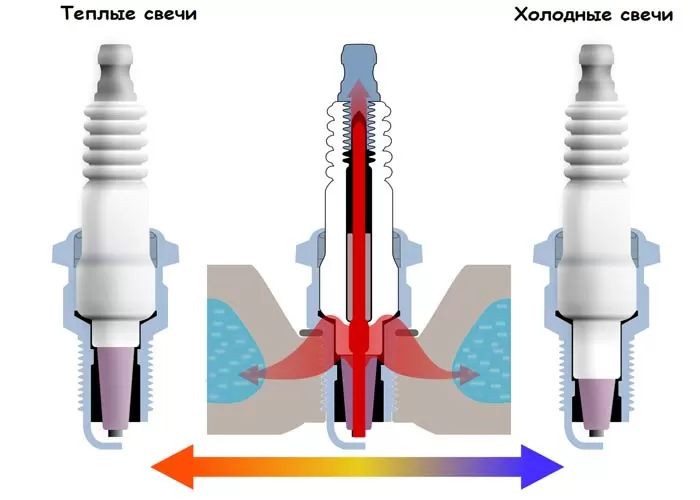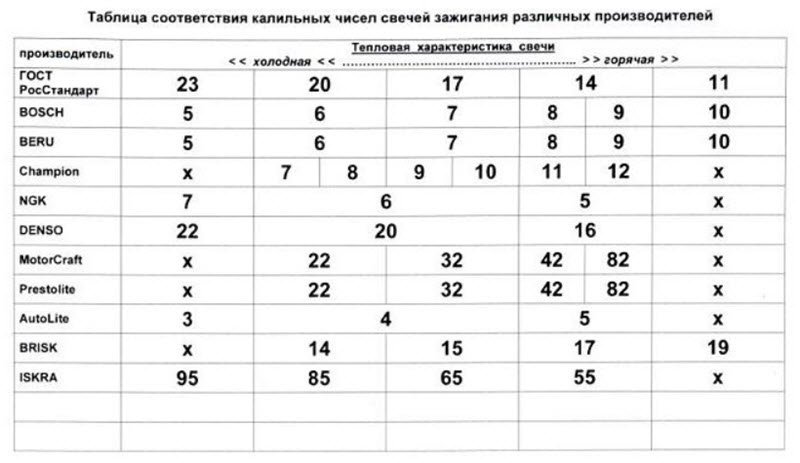
What is the difference between hot spark plugs and cold spark plugs?
Content
Information about the glow rating of a spark plug, which determines whether a spark plug is "hot" or "cold," was very valuable about half a century ago. Now the relevance of the issue has somewhat decreased, since those candles that are approved by the manufacturer are installed on the car, or their compliance is guaranteed by cross-catalogues of spare parts.

But the topic itself is interesting from the point of view of the theory of engine operation, its finer adjustment for a specific application, as well as to everyone who likes to comprehend and refine factory recommendations.
How spark plugs differ
The definitions of hot and cold candles were put in quotation marks just above, since they are extremely conditional. The candle cannot be really cold, it will immediately be bombarded with oil products and other hydrocarbons, after which a complete ignition failure will occur.
It is always hot at the self-cleaning threshold, it is another matter if this threshold shifts somewhat along the operating temperature axis.
The temperature qualities of a candle depend on many factors:
- properties of electrode and insulator materials;
- the geometry of the insulator placement relative to the body, it can protrude into the combustion chamber from the threaded part or be recessed into it;
- organization of heat removal from the protruding parts to the body of the block head.

The same spark plug, depending on the specific engine, can be either hot or cold. However, the similarity of mass design solutions gradually leads the products to the average value of the glow number, and deviations from it make it possible to classify the product as hot or cold.
Hot
Hot plugs are considered to be those that warm up quickly, so they are not thrown during a cold start or deviations in the composition of the mixture. They will also cause fewer problems to an engine with a large oil waste.

For older engines, this was very important. The imperfection of the design, low compression ratios, instability of mixture formation, especially in the starting mode, forced the use of just such ignition devices. Otherwise, the motor would simply be impossible to start at low temperatures.
A low degree of forcing did not allow the candles to overheat under maximum load. Although measures had to be taken, for example, to place a spark source in the combustion chamber.
Cold
When the hot plug overheated in the cylinder, the most dangerous source of problems appeared in the form of glow ignition. Usually, the combustion of the mixture is initiated by a spark, and it is supplied at a precisely defined moment in time.
But a hot part will cause ignition immediately, as soon as a mixture of a more or less suitable composition appears in its zone.
A detonation wave will instantly arise, the combustion front will meet the piston on the counter-stroke even before it hits the top dead center. After a short operation in this mode, the engine will be destroyed.

But the achievement by serial motors of high specific power characteristics, and even in parallel with ensuring competitive environmental friendliness and efficiency, will inevitably increase the thermal load on the spark plug to a level that previously existed only on sports engines.
Therefore, resistance to overheating, that is, intensive heat removal, was structurally necessary. Candles got colder.
But you can't overdo it either. Despite the precise mixture dosing of modern electronic injection systems, an excessively cold plug will reduce the starting characteristics of a cold engine.
At the same time, its durability will decrease, therefore, an accurate selection of ignition devices is necessary, based on engine conditions. The result is contained in the product catalog number. All analogues must confirm compatibility with it.
Features of the marking
The heat number is usually encoded in the manufacturer's designation. Together with other characteristics, geometric, electrical and the presence of features. Unfortunately, there is no single system.

To understand which devices correspond to analogues from other manufacturers, you need a plate that is easy to find. It has a comparison of the numerical values of the conditional glow number. There is no practical sense in such studies, except for some exceptions.
When to put cold and hot spark plugs
One of these rare situations is the seasonal selection of candles by glow number. Many motor manufacturers allow this by indicating a spread of one or two points on the table.
That is, in winter you can put a hotter candle, and in the summer return to the nominal value or even block it, providing protection from glow ignition, if you intend to use the maximum engine capacity in the heat for a long time.
The value of the glow number
You can be sure that candles with a glow rating of 5-6 from NGK, 6-7 from Bosch, or 16-20 from Denso will cover the needs of most civilian engines. But even here questions may arise.
In what direction can the number be considered growing, how critical is the change in the parameter by the minimum step, and so on. The correspondence table will explain a lot, but it's better not to experiment with temperature.

The required parameter has long been selected, there is an article for ordering from the catalog, and everything else is very risky. Even if the engine survives in a pre-ignition threshold environment, the spark plug itself can collapse, and its fragments will definitely cause trouble in the cylinder.
Engine diagnostics according to the condition of the candles
When determining the nature of the malfunction, it is always recommended to unscrew the candles first. Their appearance will tell a lot, specific cases are available in the form of colorful photographs, collections of which are easily available on the net.
One can only add that it is often not the state or color of the insulator that is interesting, but its comparison with the neighboring one. Especially if the scanner points to a specific cylinder.
In general, the darkening of the insulator means an excess of hydrocarbons or insufficient heating. Conversely, chipping and melting with white ceramics is a sign of overheating.
It must be understood that identifying specific causes is a difficult diagnostic task, and it is unlikely that a diagnosis will be made by color alone.
If the candles have worked out their approximate resource, and it rarely exceeds 10-20 thousand kilometers for cheap copper-nickel products, then their appearance may indicate not problems with the engine, but the wear of the candle itself. Such details change in a set, of course, and in most cases the result is pleasantly surprising.